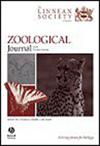国王企鹅(Aptenodytes patagonicus (Miller, 1778))肢骨显微结构的个体发育过程,以及对Sphenisciformes古生态推断的考虑
IF 3
2区 生物学
Q1 ZOOLOGY
引用次数: 0
摘要
鸟类在其进化史中占据了各种栖息地,包括水生环境。有几项研究调查了鸟类骨骼随着游泳能力的增强而发生的总体形态变化,但很少有研究详细记录了与这一过程相关的微观结构特化。然而,骨骼微观结构经常被用来重建已灭绝的水生鸟类的生态学,尽管这种关系在现代鸟类中还不完全清楚,特别是与年龄有关或无关的特异性内变异程度。为了填补这一空白,我们研究了 34 个鹦鹉螺标本从孵化到成年期间肢骨显微结构的变化。我们的研究结果表明,无论考虑的是哪个发育阶段,种内差异都很大。虽然大部分骨骼生长是在孵化后的头几个月实现的,但肢骨显微结构在整个个体发育过程中经历了重要的成熟期,直到1岁雏鸟出壳。后肢骨骼的结构和紧密度比前肢骨骼成熟得早,这反映了雏鸟陆地运动(后肢)和成鸟亚水生运动(前肢)所使用的肌肉骨骼元素在时间上的偏移。这些观察结果使我们能够对已灭绝的匙吻鲟类以前的古生态学重建进行重要的重新评估,并为严格的推论建立了一个良好的比较框架。本文章由计算机程序翻译,如有差异,请以英文原文为准。
Ontogenetic development of limb bone microstructure in the king penguin, Aptenodytes patagonicus (Miller, 1778), with considerations for palaeoecological inferences in Sphenisciformes
Birds have colonized various habitats during their evolutionary history, including the aquatic environment. Several studies have investigated the gross morphological changes of the avian skeleton in response to increasing swimming capabilities, but few have documented in detail the microstructural specializations associated with this process. Bone microstructure is nevertheless often used to reconstruct the ecology of extinct aquatic birds, although this relationship is incompletely understood in modern forms, especially for the extent of intra-specific variability related, or not, to age. In an attempt to fill this gap, we investigated the change in limb bone microstructure from hatching to adulthood in 34 Aptenodytes patagonicus specimens. Our results reveal substantial intraspecific variability, regardless of the ontogenetic stage considered. Although most skeletal growth is achieved in the first few months after hatching, limb bone microstructure undergoes important maturation throughout ontogeny until fledging, which occurs in 1-year-old chicks. Architecture and compactness in hindlimb bones mature earlier than in forelimb bones, reflecting the time offset in the use of musculoskeletal elements involved in terrestrial locomotion in chicks (hindlimbs) and sub-aquatic locomotion in adults (forelimbs). These observations allow critical reassessment of previous palaeoecological reconstructions in extinct Sphenisciformes and set a good comparative framework for rigorous inferences.
求助全文
通过发布文献求助,成功后即可免费获取论文全文。
去求助
来源期刊
CiteScore
6.50
自引率
10.70%
发文量
116
审稿时长
6-12 weeks
期刊介绍:
The Zoological Journal of the Linnean Society publishes papers on systematic and evolutionary zoology and comparative, functional and other studies where relevant to these areas. Studies of extinct as well as living animals are included. Reviews are also published; these may be invited by the Editorial Board, but uninvited reviews may also be considered. The Zoological Journal also has a wide circulation amongst zoologists and although narrowly specialized papers are not excluded, potential authors should bear that readership in mind.

 求助内容:
求助内容: 应助结果提醒方式:
应助结果提醒方式:


